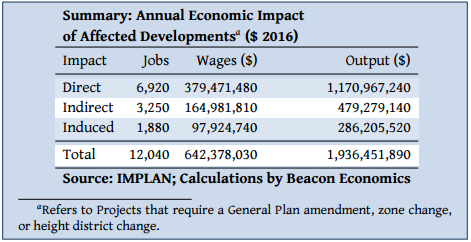The Neighborhood Integrity Initiative, now known as Measure S on the March ballot, could deprive Los Angeles of an estimated $1.9 billion in economic output, according to a new report commissioned by the policy’s opponents.
In addition to stifling economic activity, the proposed two-year moratorium on developments that require a General Plan amendment could deprive the city of over 24,000 jobs and diminish its budget by $140 million in sales and property tax over those two years, a study by Beacon Economics shows.
The consulting firm said it had generated a “conservative estimate” of the moratorium’s economic impact by analyzing 10 years of permit data on projects that required a zone change or height change as well as data on the average costs of construction based on current market trends. The report was commissioned by the Coalition to Protect L.A. Neighborhoods and Jobs, the anti-Measure S campaign.
 A spokesperson for the Coalition to Preserve L.A., the group backing the initiative, was not immediately available for comment on the numbers.
A spokesperson for the Coalition to Preserve L.A., the group backing the initiative, was not immediately available for comment on the numbers.
“The actual impact would probably be larger if you accounted for the recent growth in demand for housing,” Beacon founder Chris Thornberg told The Real Deal. “I’d say we have the best case scenario for losses.”
Thornburg and his colleagues found that such projects generated $7.4 billion in output for Los Angeles during the 10-year period between July 2006 and June 2016, $4.6 billion of which comprised direct spending on construction goods and services and $2.7 billion of indirect spending. During that same period, those projects examined by Beacon supported about 47,000 jobs, the majority of which were in construction.
In its first year, Measure S would result in the loss of 12,000 potential jobs, including 6,900 in construction, Beacon said. Those jobs represent about 15 percent of all construction employment in the city.
Such drastic job loss would lead to the stagnation of population growth in L.A. — “the scariest consequence of the measure,” Thornberg argued.
“When we’re not building housing here, the question becomes, ‘Do we want L.A. to become Country Club California?'” he added. “[Shortage] in housing is going to cause massive gentrification, and will push all the poor people out.”
